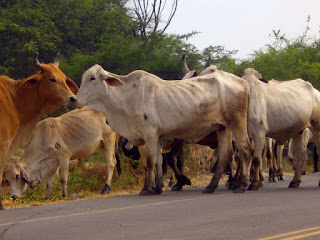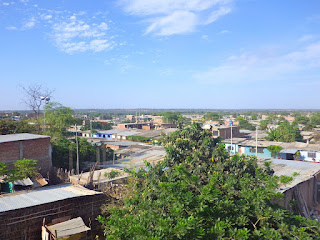I am very proud to be able to focus this part of the weblog and discussion of my trip with my grandson Sevryn in mind. I know that he and his classmates at room three in McKee School in Edmonton are studying Peru in their Social Studies class, and I hope that his teachers Mr. Stiven and Mrs. G. are able to share my contribution to Sevryn's class project on Peru.
Sevies' Mom informed me that this Social Studies project was taking place, so I have given some thought as to how best portray what I see to Sevryn and his classmates. I am very pleased that the class is using Social Studies to become more aware of the world around them, and this goal is very similar to my desire to travel and visit the countries of Central and South America.
I know that Sev's teachers have talked about directions, and how we learn to orient ourselves according the the four primary directions. I always like using the phrase: Never Eat Soggy Weiners as a way to remember which direction I am travelling, whether it be NORTH, EAST, SOUTH, or WEST.
I think we all know that the PERU is south of Canada, and in fact I have been travelling for over 3 months on my motorcycle, so that gives you an idea how far SOUTH the country of Peru actually is. I am sure that most of the class has visited the United States at one time or another, and if they travelled by car, they had to cross what is called the BORDER, between CANADA, and the United States. I have had to pass through 8 different borders in order to arrive at the SOUTHERN border of ECUADOR,where it took about 3 hours to enter PERU.
At the border, we met a man from AUSTRIA, who was riding a HONDA TRANSALP. Unfortunately he was unable to leave ECUADOR, as he had overstayed his time in that country, and he was going to have to deal with the authorities in QUITO, which is the capital of ECUADOR.
Not far down the road south, we were stopped at a military checkpoint, which is not uncommon in Central and South America. The soldiers are doing their duty, which is to monitor traffic in their respective countries. Most of the time, the young men are friendly and very interested in the motorcycles.
While our documents were being processsed, a GERMAN couple drove up in a UNIMOG, which is a special truck manufactured in EUROPE. They were travelling NORTH towards CANADA. Their truck was fitted out for all sorts of road conditions, and the couple had sleeping quarters inside their truck.
The couple were well-travelled, and they were able to tell us some interesting details about the road conditions further SOUTH.
As we left the military checkpoint, the road dropped in elevation and we entered into a very dry area, with scrubby trees, and a DESERT-like terrain. The few houses that we saw were built of mud-bricks, called ADOBE, and the surroundings were very dusty and dry.
We stopped at a Restaurant, and watched as two horses came across the highway to find some water to drink.
As I said the land was very dry, and the river that we could see had very little water in it. We passed through an area where there were many goats and they appeared to be roaming free. They wandered on the highway and had little fear of traffic, although they were dangerous for drivers and vehicles.
Goats are able to survive in a dry climate such as this, but they eat all of the foliage, which leaves the trees more barren...
Goats will eat almost any vegetation, and it seemed that their presence contributed to the dry and arid appearance of the land and surroundings.
After riding for 50 or so kilometers, the land and vegetation began to appear more greener, and the trees looked much healthier. It was clear that the presence of a CANAL full of water was the reason there was a change in the appearance of the land. ORCHARDS began to appear, and we could see that crops were being grown in the fields, irrigated by the Water in the CANAL.
The orchards were full of trees which were bearing huge fruits which appeared to be MANGOS.
The machines used to harvest the HAY in the fields was smaller than those large tractors that we are familiar with in Canadian farms, although they were used for the same purpose, which was to provide feed for the local cattle.
The cattle are different breeds than what we normally see in Canada..
And the cowboys wear bigger hats in Peru because the sun can be very hot...
The mountains that are in this picture are to the EAST, and we have been travelling down the PANAMERICAN highway for the most part, which follows a NORTH-SOUTH direction.
After ahwile, we came upon more orchards, and the fruits were able to survive because of the IRRIGATION CANALS which supplied the neccessary water to the small villages.
Many of the people use donkeys for TRANSPORTATION. These small animals are very strong...
Horses are used to herd cattle
Without the water, the villagers would not survive..the land is very sandy and the air is dry...
Unfortunately, the dry conditions create very sandy roads, and my friend had difficulty and crashed his bike. We had to return to a nearby town, where we were able to get some help fixing the broken parts.
These children were very interested in the motorcycles, and when I told them that my grandson was studying Peru in his school in Canada, we were able to have a great conversation about the importance of going to school. It appears that not all Peruvian children enjoy an effective education, as they are often living in small and remote villages.
This sunset illustrates that this area of Peru is very flat...
The mechanics at the local HONDA shop did an excellent job of repairing the damage and making the bike rideable...
These three wheeled moto- taxis are everywhere in the major cities and towns. We have also seen them far out in the country-side.
Peruvian people are very faithful to their RELIGION, and during the evening a ceremony near a CHURCH took place...
Although we were in a fairly large city, most of the buildings were single storied...
In the interior of each house, there is a courtyard, where chickens and turkeys may be kept.
The buildings are mostly built of mud brick ADOBE....
The SHELTERS usually have metal roofs, although in the poorer villages, the roofs were made of thatched straw...
Some of the larger buildings are built of stronger fired brick. The blue container at the top contains the water for the whole building...
More moto-taxis...
Some young boys who were very interested in Canada....
We travelled further SOUTH, and needed to stop at another motorcycle shop as the bike's computer was not working properly.
The Peruvian money unit is the SOLE, so this tri mots is selling for $5,490 soles....
There was a display of CHRISTMAS decorations in a local park....
































































































No comments:
Post a Comment
Note: Only a member of this blog may post a comment.